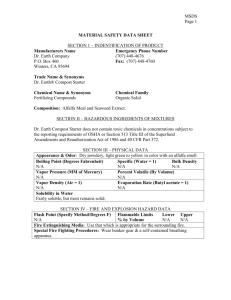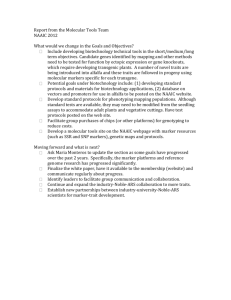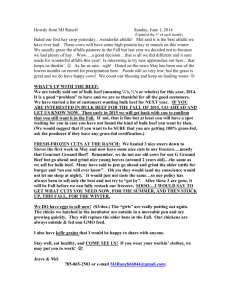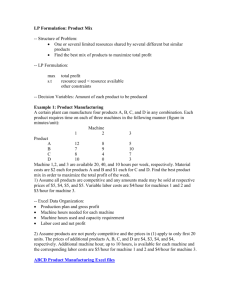Dan Putnam, Joe Brummer, Dennis Cash, Alan Gray, Tom Griggs,... Ray, Willie Riggs, Mark Smith, Glenn Shewmaker, and Rodney Todd
advertisement
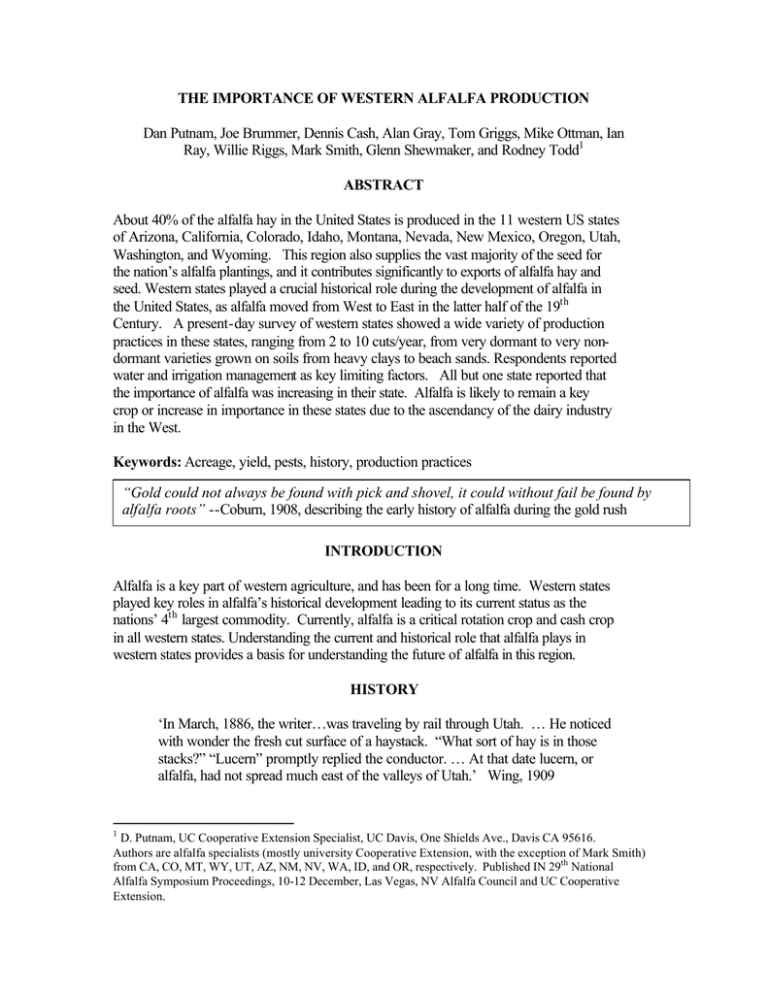
THE IMPORTANCE OF WESTERN ALFALFA PRODUCTION Dan Putnam, Joe Brummer, Dennis Cash, Alan Gray, Tom Griggs, Mike Ottman, Ian Ray, Willie Riggs, Mark Smith, Glenn Shewmaker, and Rodney Todd1 ABSTRACT About 40% of the alfalfa hay in the United States is produced in the 11 western US states of Arizona, California, Colorado, Idaho, Montana, Nevada, New Mexico, Oregon, Utah, Washington, and Wyoming. This region also supplies the vast majority of the seed for the nation’s alfalfa plantings, and it contributes significantly to exports of alfalfa hay and seed. Western states played a crucial historical role during the development of alfalfa in the United States, as alfalfa moved from West to East in the latter half of the 19th Century. A present-day survey of western states showed a wide variety of production practices in these states, ranging from 2 to 10 cuts/year, from very dormant to very nondormant varieties grown on soils from heavy clays to beach sands. Respondents reported water and irrigation management as key limiting factors. All but one state reported that the importance of alfalfa was increasing in their state. Alfalfa is likely to remain a key crop or increase in importance in these states due to the ascendancy of the dairy industry in the West. Keywords: Acreage, yield, pests, history, production practices “Gold could not always be found with pick and shovel, it could without fail be found by alfalfa roots” --Coburn, 1908, describing the early history of alfalfa during the gold rush INTRODUCTION Alfalfa is a key part of western agriculture, and has been for a long time. Western states played key roles in alfalfa’s historical development leading to its current status as the nations’ 4th largest commodity. Currently, alfalfa is a critical rotation crop and cash crop in all western states. Understanding the current and historical role that alfalfa plays in western states provides a basis for understanding the future of alfalfa in this region. HISTORY ‘In March, 1886, the writer…was traveling by rail through Utah. … He noticed with wonder the fresh cut surface of a haystack. “What sort of hay is in those stacks?” “Lucern” promptly replied the conductor. … At that date lucern, or alfalfa, had not spread much east of the valleys of Utah.’ Wing, 1909 1 D. Putnam, UC Cooperative Extension Specialist, UC Davis, One Shields Ave., Davis CA 95616. Authors are alfalfa specialists (mostly university Cooperative Extension, with the exception of Mark Smith) from CA, CO, MT, WY, UT, AZ, NM, NV, WA, ID, and OR, respectively. Published IN 29th National Alfalfa Symposium Proceedings, 10-12 December, Las Vegas, NV Alfalfa Council and UC Cooperative Extension. One cannot ignore the role that western farmers have played in the historical development of alfalfa, and its current position as a top crop in Western states. Alfalfa seems to have ‘always been there’ as a key mainstay crop for western ranches. It is often considered a ‘bread and butter’ crop that has paid a lot of bills and sustained many a landowner and ranch hand. This has been true from the earliest development of western ranches and farms. Although many other crops have also gained importance over the past 150 years, alfalfa has retained its important stature as a top economic crop in the West today. Photo from Imperial Valley, CA , early 20th Century (Coburn, 1909). Although there is ample evidence that alfalfa was grown experimentally or on small fields the eastern US prior to its production in the West, the crop did not take hold firmly in the US until it was adapted in western states during the latter half of the 19th Century. Alfalfa may have been introduced into Texas, New Mexico, and California from Mexico during the Mexican period. Thomas Jefferson and George Washington probably grew alfalfa in Virginia, and there are writings about alfalfa being grown in South Carolina and New York in the early 1800s (Coburn, 1909). However, it was not until the major introduction of ‘Chilean clover’ or alfalfa into California during the gold rush of 18491852, and its near instantaneous success under irrigation that alfalfa was able to grow to the status it enjoys today. Alfalfa is a crop that moved from West to East, whereas most crops have moved from East to West in the United States. The economics of the gold rush era, which favored the suppliers of food, blue jeans and pickaxes over the profitability of gold mining, enabled alfalfa to be successful during the Gold Rush. Practically everything, after all, was animal-powered, and cattle were the key focus of western ranching. E.J. Wickson, early director of the California Experiment Station, reported that the earliest recorded sowings in California were in Marysville in the Sacramento Valley in 1851, with seed brought from Chile by Americans who stopped there on their way from the East (Coburn, 1909). He knew of no earlier sowings in California by the Spanish colonists or California natives. Development of irrigation systems was key, and alfalfa was there at the earliest development of irrigation. For example, the first irrigation project in Yolo County (near present day Davis, CA), "James Moore’s ditch", was built in 1854, and within a few years irrigated nearly 15,000 acres of alfalfa and about 300 acres of grapevines, the major irrigated crops in the county. These gold rush introductions (there were likely more than one), appeared to have rapidly spread from the Northern California to the deserts and high mountain plains and valleys of many expanding western states. “Now little fields were cleared from their encumbering sagebrush and grease wood, the water turned on, and they were planted to corn and alfalfa. It was called lucern then. At first the alfalfa did not thrive along Range Creek. It made a small feeble growth, but it stuck. The next year the alfalfa there grew so high that when the burros would walk out into it only their heads would be visible. It produced four crops of hay and easily 8 tons to the acre.” --- Wing, 1909 The crop alfalfa was a perfect match for the expanding West of the 19th century. It was perfectly adapted to the western arid regions under irrigation, and versatile enough to be grown on both heavy soils and light soils. It could be both grazed or hayed for home use, and sold as a cash crop; alfalfa was a cash crop in many western states from the earliest point. There were plenty of cattle and horses around, and ready markets for alfalfa could be had locally, whereas many other commodities relied on far-away markets. Alfalfa’s early success provided deep roots for its role in western agriculture today. WHERE IS ALFALFA GROWN IN THE WEST? Alfalfa is currently an important crop in all 11 western US states of Arizona, California, Colorado, Idaho, Montana, Nevada, New Mexico, Oregon, Utah, Washington, and Wyoming. These states total 7.4 million acres, or 31.2% of the US Modern alfalfa production field and alfalfa stacked ready for shipping to dairy markets. This field is in the Imperial Valley of California. acreage, and produce 33 million tons per year, or 40.5% of the US production of alfalfa (Figure 1, 1997-1999 data, source: USDA Ag Statistics Service). Similar figures for total hay production (including grass hays) are 22.6% of the US acreage and 27.2% of the US production (Figure 1). Alfalfa hay acreage in Montana is greater than any other western state, followed by Idaho, California, and Colorado (Figure 1). Production of alfalfa hay is greatest in California due to the higher yields in that state. Greater than 80% of CA’s hay is grown in regions where 7-10 harvests are possible. In each of these western states, alfalfa is either the first, second, or third most important crop in acreage according to USDA figures (Table 1). These data indicates that alfalfa is a somewhat more significant in acreage in these states than it is in the US as a whole, where alfalfa ranks fifth in acreage (behind corn, soybean, all types of wheat, and other types of hay). Alfalfa Hay Production (tons/year X 1,000) Alfalfa Hay Acreage (X 1,000) 0 200 400 600 800 1000 1200 1400 1600 0 1800 2000 3000 4000 5000 6000 7000 Arizona Arizona California California Colorado Colorado Idaho Idaho Montana Montana Nevada Nevada New Mexico New Mexico Oregon Oregon 38% of U.S. Utah 40% of U.S. Utah Washington Washington Wyoming Wyoming All Hay Acreage (X 1,000) 0 400 800 1200 1600 2000 2400 All Hay Production (tons/year X 1,000) 2800 0 Arizona Arizona California California Colorado Colorado Idaho Idaho Montana Montana Nevada Nevada New Mexico 1000 2000 3000 4000 5000 6000 7000 8000 New Mexico Oregon Utah 1000 Oregon 23% of U.S. Utah Washington Washington Wyoming Wyoming 27% of U.S. Figure 1. Total (all) hay acreage and alfalfa hay acreage and production, 11 western US States, and % of total U.S. states, average of 1997-1999 data, USDA Agriculture Statistics Service. 9000 RESULTS OF A SURVEY OF WESTERN STATES To understand the range of alfalfa production practices, a survey was conducted with alfalfa specialists in 11 western states in the fall of 2000. This survey revealed some interesting things about western alfalfa, indicating a very wide diversity of growing conditions, and economic constraints. Soil types where alfalfa is grown vary from very heavy clay type soils to very sandy ‘beach sands’, to volcanic soils or organic soils, and from true deserts to cool Intermountain Valleys. While irrigation is necessary in most western states, there are significant regions with dryland alfalfa. In some regions, alfalfa is rotated primarily with wheat, corn or barley, while in other regions it is rotated with high value crops such as lettuce, tomatoes, onions and potatoes. Results of this survey are presented in Tables 2-5. The average yield of alfalfa in western states is highly variable (Table 2). The average yield in western states of 4.7 tons/acre is 136% of the national average of 3.4 tons/acre. The lowest-yielding state was Montana (2.4 tons/acre), also the highest acreage state, which has considerable acreage under dryland conditions. Much of the dryland alfalfa grown in western states such as Montana is harvested only once or twice. Arizona is the highest-yielding state, with an average of about 7.9 tons/acre. Arizona grows mostly non-dormant varieties under irrigation, and alfalfa is harvested 8-10 times per year. Considerable differences exist within western states as well. For example, in California there is production in Intermountain areas at 5,000 feet above sea level (2-3 cuts) as well as desert production 200 feet below sea level (8-10 cuts). Latitude, elevation, soil type, and availability of irrigation water are primary determinants of yield potential. Irrigation practices, cutting schedules, varieties, and persistence of stands vary considerably from state to state (Table 2). Across the region, about 77% of the alfalfa is irrigated (using estimates for irrigated amounts given by the respondents), but the amount within a state ranged from 50% to 100% of the acreage irrigated (Table 2). Number of cuts range from 1 to 10, and fall dormancy classes from 1 to 10. Stands appear to last shorter periods in the warmer climates (3-4 years in AZ, CA, NM) to much longer stands in intermountain regions. Major insect pests include the alfalfa weevil and Egyptian Alfalfa weevil, armyworms, an aphid complex which includes the blue alfalfa aphid, spotted alfalfa aphid, pea aphid, and more recently, the cowpea aphid (Table 3). Diseases are probably less of a problem in most western states than in the more humid eastern US, but include phytophthora root rots, stem and root knot nematodes, verticillium wilt, anthracnose, and sclerotinia (Table 3). It’s difficult to generalize weed problems over such a large area, but winter annuals such as mustards and groundsel, summer annual grasses such as foxtail, and perennials such as quackgrass were noted (Table 4). Vertebrate pests are not often thought of in a discussion of crop pests, but vertebrate pests are a major limiting factor on many western alfalfa fields, especially in the intermountain regions. Pocket gophers, meadow voles, and ground squirrels are most commonly cited. Larger vertebrates, such as elk and deer are considered major crop limiting problems in some western states (Table 4). Respondents were asked to name the three most important limiting factors in their states. It is not surprising that irrigation management and water availability were cited as the top limiting factors in most western states. Weather and haying conditions, cutting schedule, soil fertility, soil problems, rodents, and pest control issues were also frequently cited. All but one state reported that alfalfa is currently increasing in acreage or importance in their state, and that this trend would continue. The most frequent reason cited for this trend is increased demand by an expanding dairy industry, other market demands, and lack of profitable alternative crops. Water limitations, water costs, and the replacement of alfalfa with higher-value crops have historically limited alfalfa expansion, and will likely continue to do so in some states the future. However, counteracting this trend, demand for high quality alfalfa hay is continuing to expand as many western states have relentlessly expanded their dairy industries. The most dramatic increases in dairying have been in Idaho, New Mexico and California. THE FUTURE Alfalfa is currently a major factor in the cropping systems of all western states. It is often the first or second crop in acreage and a top crop in economic value to western states. Many ranches depend heavily upon alfalfa as a mainstay crop, or as a key rotation crop to grow with ‘higher risk’ crops, and many ranches would fail without it. It is interesting that alfalfa is perceived in most of the 11 western states as increasing in importance or acreage in the future. This perception is due primarily to the phenomenal rise of dairying in western states and other market forces. Unlike many commodities (e.g. wheat, barley, cotton), which are tied closely with international markets, the market for alfalfa is linked primarily with localized or regional demand. Since dairying and recreational horses are continuing to expand in western states, this bodes well for the long-term demand for alfalfa, even if temporary market conditions create surpluses of alfalfa in any given year. There is no question that alfalfa faces major challenges in the future, including competition for water supplies from urbanization, loss of productive farmland, replacement of alfalfa with other crops, and regulatory pressures. However, in spite of these challenges, alfalfa remains the premier forage for the growth of the dairy industry in western states, and there is little doubt that it will remain important in the future. REFERENCES Coburn, F.D., 1908. The Book of Alfalfa. History, Cultivation and Merits, its uses as a Forage and Fertilizer. Orange Judd Co., New York. Wing, J. E. 1909. Alfalfa Farming in America. Sanders Publishing Co., Chicago, IL. Table 1. Top five ranked crops in acreage in 11 western states and in the USA in 1997 (USDA Agricultural Statistics Service). ‘Hay’ indicates hay other than alfalfa. Rank 1 2 3 4 5 AZ Cotton Alfalfa Wheat Corn Barley CA Cotton Alfalfa Grapes Wheat Hay CO Wheat Corn Alfalfa Hay Sorghum ID Wheat Alfalfa Barley Potatoes Hay MT Wheat Alfalfa Barley Hay Oats NV Hay Alfalfa Wheat Potatoes Barley Rank 1 2 3 4 5 NM Wheat Alfalfa Sorghum Corn Hay OR Wheat Hay Alfalfa Barley Oats UT Alfalfa Wheat Hay Barley Corn WA Wheat Barley Alfalfa Hay Apples WY Alfalfa Wheat Barley Corn Sugarbeets USA Corn Soybean Wheat Hay Alfalfa Table 2. Information on average yield, economic rank (cash receipts), irrigation, number of harvests, fall dormancy classes of the varieties grown, and persistence estimates of 11 western states, results of a survey of western alfalfa specialists (with the exception of average yield, which is from USDA data, average of 1997-1999). State Arizona California Colorado Idaho Montana Nevada N. Mexico Oregon Utah Washington Wyoming Ave. Yield (t/a) 7.9 6.8 3.8 4.0 2.2 4.1 5.2 4.4 4.4 4.9 2.7 Economic Rank in State 5-7 3 5 1 3 2 3 5-6 - Acreage Under Irrigation 98% 100% 89% 79% 50% 100% 90% 80% 67% 95% 68% Cuts/Year 8-10 3-10 1-4 2-5 1-3 3-4 3-8 3-5 1-7 3-5 1-4 FD Classes Grown in State 8-9 3-10 2-4 2-6 1-4 3-5 3-9 2-5 3-6 3-6 2-4 Stands Replaced Every 3 years 3-4 years 3-8 years 5 years 7-15 years 8 years 3-5 years 6 years 6-20 years 3-5 years 4 years Table 3. Major Insect and disease problems in 11 western states, results of a survey. State Arizona California Colorado Idaho Montana Nevada N. Mexico Oregon Utah Washington Wyoming Major Insect Pests Aphid Complex E. Alfalfa Weevil Alfalfa Weevil Cutworm (armyworm) E. Alfalfa Weevil Aphid Complex Aphid Complex Weevil - Major Diseases Beet Armyworm Armyworms Army cutworms Clover root curculio - Phytophthora Rhizoctonia Sclerotinia Verticillium Phytophthora Verticillium Phytophthora Verticillium Nematodes Phytophthora Verticillium Phytophthora Anthracnose Fusarium Phytophtora Verticillium Wilt Stem Nematode Stem Nematode Stem Nematode Alfalfa Weevil Aphid Complex Aphid Complex Cutworms Pea Aphid Thrips Clover root Curculio Verticillium Wilt Verticillium Wilt Alfalfa Weevil - - Phytophthora - Stem Nematode Stem Nematode Stem Nematode Aphid Complex Aphid Complex Alfalfa Weevil Alfalfa Weevil Thrips Alfalfa Weevil Armyworm (Scald) Phytophthora Bacterial Wilt Stem Nematode Phytophthora Root Knot Nematode Stem Nematode Verticillium Table 4. Major weed and vertebrate pest problems, 11 western states, results of a survey. State Major Weed Problems Major Vertebrate Pests Arizona California Colorado Summer Annuals G. & Y. Foxtail Nutsedge Mustards Groundsel/ Fiddleneck Foxtail Barley Flisweed G. Foxtail Quackgrass Bulbous bluegrass Montana Winter Annuals Dandilions Quackgrass Nevada Mustards Bluegrass - London Rocket Tansy Mustard Foxtail/ Dodder Mustards Quackgrass K.Bluegrass Quackgrass Dandilion Foxtail Barley Washington Mustards Lambsquar ters - Wyoming Dandelion Quackgrass Canada Thistle Idaho N. Mexico Oregon Utah Pocket gophers Pocket gophers Gophers Meadow voles Pocket gophers B. Ground squirrels - - Voles Ground Squirrels Prairie dogs/ squirrels Deer/elk Marmets Elk Squirrels - Gophers - Gophers Deer B. Groundsquirrel Pocket gophers Meadow Voles Pocket gophers Pocket Gophers Mice Meadow Voles Prairie Dogs Pocket Gophers - - - Table 5. Listing of the most important yield limiting factors and current trends for alfalfa in Western States, results of a survey. The questions were: What are the most important yield limiting factors in your state? Is alfalfa currently increasing, decreasing, or there is no change in acreage or importance? What are the causes? Will this trend continue? Change in Will this Importance trend State Most important Limiting Yield Factor of alfalfa Causes continue? Demise of Harvest Arizona Temperature Water Increasing cotton, Yes Losses dairies Dairy Irrigation Cutting California Pest Control Increasing Yes Industry, no Management Schedule alternatives Dairies, New InsectCutting Colorado Salinity Increasing Water No diseases Schedule Projects Dairy Herd Idaho Water Temperatures Soil Fertility Increasing Yes Expansion Fall Drought, Weather/ Poor Haying Montana Increasing No Grazing/Irriga limitations on Season Conditions tion grazing land Nevada Weather Rodents Insects/Weeds Dairy Cutting N. Mexico Water Varieties Increasing Industry Yes Schedule Expansion No alternatives, Oregon Irrigation Drainage Frost Increasing Yes market demand Soil Distance to Water Irrigation Properties Utah No Change Yes High Value Availability (salinity, Management Markets drainage) Demand, Poor Drying Irrigation Increasing University Washington Weeds Yes Conditions Management Slightly Extension Support OverUnderSoil Fertility Market Wyoming Increasing Yes irrigation irrigation (P) Demand


